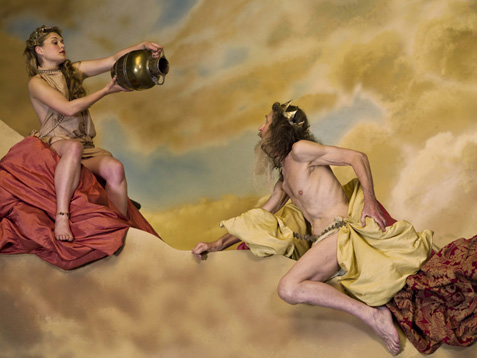Lying on my back on the floor of the Kimbell Art Museum the other day, I got to thinking about Van Halen. Unfolding across the ceiling above me and about 15 other museumgoers, also on their backs, was a short film inspired by Giovanni Battista Tiepolo’s “Apollo and the Continents,” a large sketch for the fresco that Tiepolo painted on the ceiling of the Palazzo Clerici in Milan. Actors in various states of undress, relaxation, and play scrolled slowly across the makeshift screen. A topless woman here. A man in a toga there.
All backdropped by bright blue sky. Toward the film’s end the parade of characters is revealed to be mere framing around a toga-clad man who descends from the sky to linger in gilded grandeur at the center of the tableau. He is Apollo, ancient Greece’s answer to David Lee Roth, a figure with flowing flaxen hair who is untouchable but as familiar as any family member.
 You could say that the genius here is filmmaker Philip Haas and his ability to relate a Western classic to a contemporary sensibility. As a painting, “Apollo and the Continents” might not warrant more than a few seconds’ pause, a jaw-dropping few seconds but a few nonetheless. However, as a film — or, rather, a painting brought to life — the piece demands the viewer’s full focus for at least five minutes. Credit to Haas for rewarding attentive viewing.
You could say that the genius here is filmmaker Philip Haas and his ability to relate a Western classic to a contemporary sensibility. As a painting, “Apollo and the Continents” might not warrant more than a few seconds’ pause, a jaw-dropping few seconds but a few nonetheless. However, as a film — or, rather, a painting brought to life — the piece demands the viewer’s full focus for at least five minutes. Credit to Haas for rewarding attentive viewing.
The film is part of Butchers, Dragons, Gods & Skeletons, five shorts ranging in length from about five to 20 minutes, directed by the Oscar-nominated filmmaker (Angels & Insects, 1995) and installed in various nooks throughout the museum building. The exhibit, quite possibly the first of its kind anywhere, was commissioned by the Kimbell, perhaps presaging a bold new direction for the vaunted classical museum. In addition to “Apollo and the Continents” (c.1739), Haas also chose to interpret James Ensor’s “Skeletons Warming Themselves” (1889), Douris’ “Red-Figure Cup Showing the Death Pentheus” (c. 480 B.C.) the ancient Chinese scroll painting “Arhat Taming the Dragon” (Yuan dynasty, early 14th century), and Annibale Carracci’s “The Butcher’s Shop” (early 1580s).
“The Butcher’s Shop” was the first piece to be completed and is easily the most literal. On opposing sides of a tiny Kimbell gallery are two screens. On one are the painter and his assistant. On the other, the two titular butchers. The painter and his subjects interact, keeping the viewer’s head on a swivel. Other than the amazing livestock innards, though, there’s not much to gawk at. All of the other films are equally accessible but more progressive, more “arty.”
“Skeletons Warming Themselves,” based on Ensor’s painting of several skeletons in cloaks of various muted colors milling around a furnace in an empty room, is a spooky fever dream, a slow meander through a masquerade, a prop shop populated by charmingly grotesque masks, and the painter’s life from infant to adult to old man. Shadows crowd the action, and composer Angelo Badalamenti’s haunting score points up the shifts in visual tone. Ensor fans will be pleased to discover that some of the townspeople re-enact some of the Belgian painter’s most memorable pieces, including “The Drunkards” (two men sliding off their chairs at a café table), “The Skeleton Painter” (a boy in a skeleton mask, standing at an easel), and the alarmingly cute “Skeletons Fighting Over a Pickled Herring,” two skeleton heads joined at the mouth by the titular fish. In the film, the two tug at each other wildly.
The screening room for “Skeletons” is located inside a giant, cockpit-sized skeleton head made from reproductions of photographs of Ensor and copies of the edition of De Standaard emblazoned with the headline “Baron James Ensor overleden” (“James Ensor is dead”).
Equally life-affirming is Haas’ filmic interpretation of “Arhat Taming the Dragon,” the story of an arhat, a Buddhist saint of wisdom and supernatural powers, who through incantations wills a dragon from a rushing river into his alms bowl, symbolizing man’s ability to triumph over the inclement forces of nature. Projected inside a wooden shrine that also appears in the film, Haas’ “Arhat” opens on a meek-looking monk fishing at night. On his way home through the woods after a successful outing, he finds a shuttle (a handheld wooden weaving tool) and takes it home with him. He doesn’t realize until later that the shuttle is magical — it transports him into a dream in which he plays the guardian king to the arhat. Quite easily the most laugh-out-loud adorable scene is when the shuttle sneaks into a scroll that the meek-looking monk is painting — moments later a diminutive though fearsome set of red claws with sharp black nails tears through the paper from underneath.
“The Death of Pentheus” is the only miss, though not because of any cinematic deficiencies. Rather, the layout is poor. The piece is shown on a circular screen that’s pretty much lying flat on the Kimbell auditorium floor. Even from the top rows, the action is constantly receding from you, testing not only your ability to stay focused but also your patience.
Like the bowl from which the filmmaker has taken inspiration, the action unfurls in tondo format: a single central image framed in circular fashion by smaller images. The story is about Pentheus, the young king of Thebes who opposes Dionysiac bacchanalia and in return for his resistance is torn apart by Theban maenads (female followers of Dionysus). The film incorporates a lot of ominous plucked-violin music, courtesy of composer Alexander Balanescu, Greek folk song (taken from Euripides’ play The Bacchae), and frenetic imagery. Dionysus and his wife Ariadne play the drinking game of kottabos (throwing lees at floating targets), the god and his satyrs harvest grapes, potters form and fire the ancient kiln. The mood is appropriately dour all around and perhaps all too tangible.
Which is to say that Haas’ pieces are super-arty. Except for “The Butcher’s Shop,” the films are mostly nonlinear, with no clear beginnings, middles, and ends. And what little dialogue exists is not in English, which might not exactly help the average Kimbell patron get to know — and care about — the characters.
Regardless, every film in Butchers, Dragons, Gods & Skeletons is eminently watchable. Somehow, they always achieve drama, hinting that something onscreen is at stake, enough possibly to keep even the flightiest mind from coming unchained and wandering off.
Butchers, Dragons, Gods & Skeletons
Thru Oct 25 at Kimbell Art Museum, 3333 Camp Bowie Blvd, FW.
817-654-1034.











